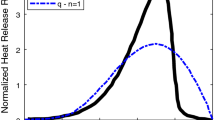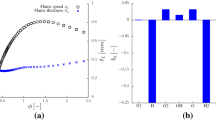Abstract
This paper presents a numerical study by RANS modeling that investigates the effect of external dilution on the premixed combustion occurring in a recuperative furnace. Calculations are performed using the detailed GRI-Mech 3.0 mechanism to ensure the accuracy of the modeling. Results of the in-furnace flow, temperature, and concentrations of OH, O2, CO2 and NO x are provided. It is found that the external dilution with the inert gas CO2 plays a significant role in establishing the premixed MILD (Moderate or Intense Low-oxygen Dilution) combustion. Externally diluting the reactant mixture not only reduces the initial concentration of O2 but also ensures a stronger internal dilution by recirculation of more hot combustion products. Importantly, the latter effect is more significant for achieving the MILD regime. There is a critical mass fraction of the diluent CO2 present, below which MILD combustion cannot occur. While the traditional premixed flame produces much more NO x than the MILD combustion, the emission of NO x appears to result most from the thermal-NO route and least from the N2O route no matter which mode occurs. Moreover, the present simulation demonstrates that the MILD mode occurs over a wider range of initial reactant conditions for premixed combustion than for diffusion combustion.
Similar content being viewed by others
References
Wünning, J.A., Wünning, J.G.: Flameless oxidation to reduce thermal no-formation. Prog. Energy Combust. Sci. 23(1), 81–94 (1997)
Tsuji, H., Gupta, A., Katsuki, M.: High temperature air combustion: from energy conservation to pollution reduction. CRC Press LLC, Boca Raton (2003)
Cavaliere, A., de Joannon, M.: Mild combustion. Prog. Energy Combust. Sci. 30(4), 329–366 (2004)
Mancini, M., Weber, R., Bollettini, U.: Predicting NO x emissions of a burner operated in flameless oxidation mode. Proc. Combust. Inst. 29, 1155–1163 (2003)
Weber, R., Orsino, S., Lallemant, N., Verlaan, A.: Combustion of natural gas with high-temperature air and large quantities of flue gas. Proc. Combust. Inst. 28(1), 1315–1321 (2000)
Katsuki, M., Hasegawa, T.: The science and technology of combustion in highly preheated air. Proc. Combust. Inst. 27(2), 3135–3146 (1998)
Medwell, P.R., Kalt, P.A.M., Dally, B.B.: Simultaneous imaging of OH, formaldehyde, and temperature of turbulent nonpremixed jet flames in a heated and diluted coflow. Combust. Flame 148(1–2), 48–61 (2007)
Medwell, P.R., Kalt, P.A.M., Dally, B.B.: Imaging of diluted turbulent ethylene flames stabilized on a Jet in Hot Coflow (JHC) burner. Combust. Flame 152(1–2), 100–113 (2008)
Zieba, M., Brink, A., Schuster, A., Hupa, M., Scheffknecht, G.: Ammonia chemistry in a flameless jet. Combust. Flame 156(10), 1950–1956 (2010)
Kumar, S., Paul, P.J., Mukunda, H.S.: Studies on a new high-intensity low-emission burner. Proc. Combust. Inst. 29, 1131–1137 (2002)
Kumar, S., Paul, P.J., Mukunda, H.S.: Investigations of the scaling criteria for a mild combustion burner. Proc. Combust. Inst. 30, 2613–2621 (2005)
Derudi, M., Villani, A., Rota, R.: Sustainability of mild combustion of hydrogen-containing hybrid fuels. Proc. Combust. Inst. 31, 3393–3400 (2007)
Parente, A., Galletti, C., Tognotti, L.: Effect of the combustion model and kinetic mechanism on the MILD combustion in an industrial burner fed with hydrogen enriched fuels. Int. J. Hydrog. Energy. 33(24), 7553–7564 (2008)
Wu, S.-R., Chang, W.-C., Chiao, J.: Low NO x heavy fuel oil combustion with high temperature air. Fuel 86(5–6), 820–828 (2007)
Weber, R., Smart, J.P., von der Kamp, W.: On the (MILD) combustion of gaseous, liquid, and solid fuels in high temperature preheated air. Proc. Combust. Inst. 30, 2623–2629 (2005)
Stadler, H., Ristic, D., Malte, Schuster, A., Kneer, R., Scheffknecht, G.: NO x -emissions from flameless coal combustion in air, Ar/O2 and CO2/O2. Proc. Combust. Inst. 32(2), 3131–3138 (2009)
Wang, Y.D.: The application of FLOX/COSTAIR technologies to reduce NO x emissions from coal/biomass fired power plant: a technical assessment based on computational simulation. Fuel 86, 2101–2108 (2007)
Giancarlo Benelli, G.G., Malavasi, M., Saponaro, A.: ISOTHERM®: A new oxy-combustion process to match the zero emission challenge in power generation. In: 7th High Temperature Air Combustion and Gasification International Symposium, Phuket, Thailand, (2008)
Krishnamurthy, N., Paul, P.J., Blasiak, W.: Studies on low-intensity oxy-fuel burner. Proc. Combust. Inst. 32(2), 3139–3146 (2009)
Szego, G.G., Dally, B.B., Nathan, G.J.: Operational characteristics of a parallel jet MILD combustion burner system. Combust. Flame 156(2), 429–438 (2009)
Szego, G.G., Dally, B.B., Nathan, G.J.: Scaling of NO x emissions from a laboratory-scale mild combustion furnace. Combust. Flame 154(1–2), 281–295 (2008)
Dally, B.B., Karpetis, A.N., Barlow, R.S.: Structure of turbulent non-premixed jet flames in a diluted hot coflow. Proc. Combust. Inst. 29(1), 1147–1154 (2002)
Yuan, J., Naruse, I.: Effects of air dilution on highly preheated air combustion in a regenerative furnace. Energy Fuel. 13(1), 99–104 (1999)
Dally, B.B., Craig, R.A., Mi, J.: Dependence of flameless combustion on fuel–air injection pattern and their momentum ratio in a recuperative furnace. In: Zhang, X., Liu, X. (eds.) Proceedings of the 9th Asia-Pacific International Symposium on Combustion and Energy Utilization, ISBN 978-7-5062-9284-9, World Publishing Corporation, pp. 35–40 (2008)
Mi, J., Li, P., Zheng, C.: Numerical simulations of flameless premixed combustion in a recuperative furnace. Chin. J. Chem. Eng. 18(1), 10–17 (2010)
Mi, J., Li, P., Dally, B.B., Craig, R.A.: Importance of initial momentum rate and air–fuel premixing on Moderate or Intense Low Oxygen Dilution (MILD) Combustion in a recuperative furnace. Energy Fuel 23(11), 5349–5356 (2009)
Li, P., Mi, J.: Numerical simulations of premixed MILD combustion in a recuperative furnace. In: Proceedings of the Australian Combustion Symposium, The University of Queensland, (2009)
Mi, J., Li, P., Dally, B.B., Craig, R.A.: Influence of initial air–fuel premixing on MILD combustion in a recuperative furnace. In: 2009 Sino-Australia Symposium on Advanced Coal and Biomass Utilisation Technology (2009).
Fluent 6.3 Documentation. Fluent Inc (2007)
Smith, G.P., Golden, D.M., Frenklach, M., Moriarty, N.W., Eiteneer, B., Goldenberg, M., Bowman, C.T., Hanson, R.K., Song, S., Gardiner Jr., W.C., Lissianski, V.V., Qin, Z.: available from: http://www.me.berkeley.edu/gri_mech/.
Chui, E., Raithby, G.: Computation of radiant heat transfer on a nonorthogonal mesh using the finite-volume method. Numer. Heat Transfer B-Fund. 23(3), 269–288 (1993)
De Soete, G.G.: Overall reaction rates of NO and N2 formation from fuel nitrogen. Proc. Combust. Inst. 15(1), 1093–1102 (1975)
Westbrook, C.K., Dryer, F.L.: Simplified reaction mechanisms for the oxidation of hydrocarbon fuels in flames. Combust. Sci. Technol. 27(1), 31–43 (1981)
Christo, F.C., Dally, B.B.: Modeling turbulent reacting jets issuing into a hot and diluted coflow. Combust. Flame 142, 117–129 (2005)
Dally, B.B., Karpetis, A.N., Barlow, R.S.: Structure of turbulent non-premixed jet flames in a diluted hot coflow. Proc. Combust. Inst. 29, 1147–1154 (2002)
Rottier, C., Lacour, C., Godard, G., Taupin, B., Porcheron, L., Hauguel, R., Carpentier, S., Boukhalfa, A.M., Honoré, D.: On the effect of air temperature on mild flameless combustion regime of high temperature furnace. Proceedings of the European Combustion Meeting, Austria, (2009)
Fenimore, P.C.: Studies of fuel-nitrogen in rich flame gases. Proc. Combust. Inst. 17, 661–669 (1979)
Author information
Authors and Affiliations
Corresponding author
Rights and permissions
About this article
Cite this article
Li, P., Mi, J. Influence of Inlet Dilution of Reactants on Premixed Combustion in a Recuperative Furnace. Flow Turbulence Combust 87, 617–638 (2011). https://doi.org/10.1007/s10494-011-9348-x
Received:
Accepted:
Published:
Issue Date:
DOI: https://doi.org/10.1007/s10494-011-9348-x




